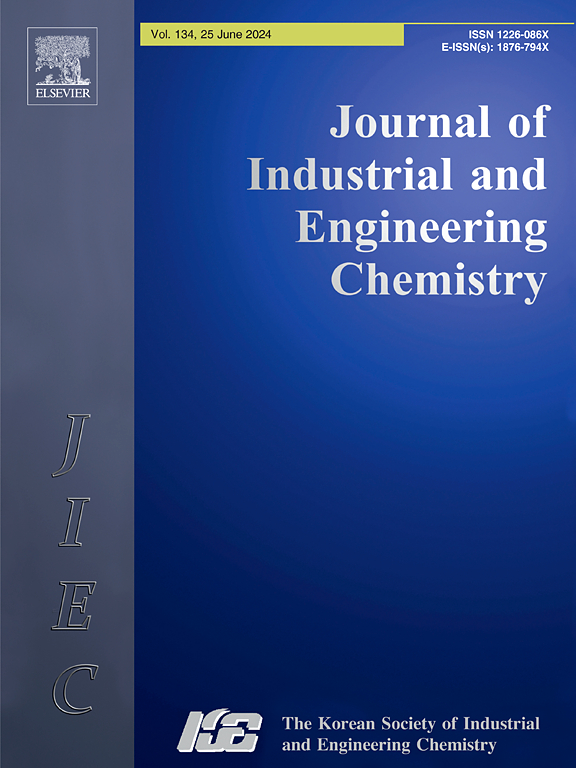In-depth insight into the driving factors of the compressive strength development of MKPC based on interpretable machine learning methods
IF 5.9
3区 工程技术
Q1 CHEMISTRY, MULTIDISCIPLINARY
Journal of Industrial and Engineering Chemistry
Pub Date : 2025-01-25
DOI:10.1016/j.jiec.2024.06.039
引用次数: 0
Abstract
Magnesium potassium phosphate cement (MKPC) is a kind of Mg-chemically bonded phosphate ceramic commonly used for rapidly repairing dilapidated structures. In this study, a compressive strength dataset of MKPC was constructed, and four advanced machine learning (ML) algorithms (XGBoost, RF, GBDT and ANN) were selected to establish a high-precision compressive strength prediction model of MKPC. The SHAP and PDP methods are also used for interpretability analysis of ML-MKPC models. The XGBoost model has good generalizability and reliability while achieving high prediction accuracy. The RF and GBDT models performed similarly to the XGBoost model on the training set but performed poorly on the testing set. The ANN model is poorly trained on both the training and testing sets, with a risk of underfitting. The R2 of the XGBoost model at the different compressive strength stages still reaches above 0.80, indicating that it not only captures the complex relationships of the overall dataset well but also effectively predicts the staged strength dataset. Feature importance analysis revealed that the curing age (T), water-to-binder ratio (W/B), mineral admixtures-to-binder ratio (MA/B) and phosphate-to-magnesium ratio (P/M) are the principal variables affecting the compressive strength of MKPC. The partial interpretation shows that the optimum value range is determined when W/B is 0.10–0.18, MA/B is 0–0.20, P/M is 0.40–1.0, and R/M is 0–0.12. The composition of mineral admixtures with high-Ca, high-Si and low-Al systems seems to be more conducive to participating in the hydration reaction of MKPC. The ML-MKPC compressive strength prediction model developed in this study can provide theoretical support for the subsequent composition design and performance optimization of MKPC.

基于可解释的机器学习方法,深入了解 MKPC 抗压强度发展的驱动因素
磷酸镁钾水泥(MKPC)是一种常用的镁化学结合磷酸盐陶瓷,用于快速修复危房结构。本研究构建了MKPC的抗压强度数据集,采用XGBoost、RF、GBDT和ANN四种先进的机器学习(ML)算法建立了MKPC的高精度抗压强度预测模型。利用SHAP和PDP方法对ML-MKPC模型的可解释性进行了分析。XGBoost模型具有良好的通用性和可靠性,预测精度高。RF和GBDT模型在训练集上的表现与XGBoost模型相似,但在测试集上表现不佳。人工神经网络模型在训练集和测试集上都训练得很差,有欠拟合的风险。XGBoost模型在不同抗压强度阶段的R2仍然达到0.80以上,表明它不仅能很好地捕捉整体数据集的复杂关系,而且能有效地预测阶段强度数据集。特征重要性分析表明,养护龄期(T)、水胶比(W/B)、外加剂与粘结剂比(MA/B)和磷酸盐与镁比(P/M)是影响MKPC抗压强度的主要变量。局部解释表明,W/B为0.10 ~ 0.18,MA/B为0 ~ 0.20,P/M为0.40 ~ 1.0,R/M为0 ~ 0.12时确定了最佳取值范围。高ca、高si、低al体系的矿物掺合料组成似乎更有利于参与MKPC的水化反应。本研究建立的ML-MKPC抗压强度预测模型可为MKPC后续的成分设计和性能优化提供理论支持。
本文章由计算机程序翻译,如有差异,请以英文原文为准。
求助全文
约1分钟内获得全文
求助全文
来源期刊
CiteScore
10.40
自引率
6.60%
发文量
639
审稿时长
29 days
期刊介绍:
Journal of Industrial and Engineering Chemistry is published monthly in English by the Korean Society of Industrial and Engineering Chemistry. JIEC brings together multidisciplinary interests in one journal and is to disseminate information on all aspects of research and development in industrial and engineering chemistry. Contributions in the form of research articles, short communications, notes and reviews are considered for publication. The editors welcome original contributions that have not been and are not to be published elsewhere. Instruction to authors and a manuscript submissions form are printed at the end of each issue. Bulk reprints of individual articles can be ordered. This publication is partially supported by Korea Research Foundation and the Korean Federation of Science and Technology Societies.

 求助内容:
求助内容: 应助结果提醒方式:
应助结果提醒方式:


